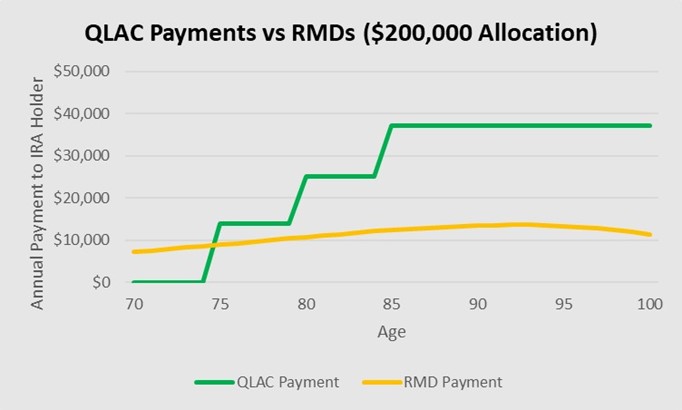This Underused IRA Option Offers Tax Benefits and Income Security
Looking to avoid running out of money in retirement? Consider longevity protection provided by a QLAC as a component of your retirement income plan.


A little more than 10 years ago, the U.S. government did something right for retirees. It created the QLAC as a way to provide longevity protection on a tax-favored basis using savings in an IRA or other qualified account. Here’s how the bill was framed:
“All Americans deserve security in their later years and need effective tools to make the most of their hard-earned savings,” the IRS said of the rationale for QLAC.
“As boomers approach retirement and life expectancies increase, longevity income annuities [our emphasis] can be an important option to help Americans plan for retirement and ensure they have a regular stream of income for as long as they live.”
From just $107.88 $24.99 for Kiplinger Personal Finance
Become a smarter, better informed investor. Subscribe from just $107.88 $24.99, plus get up to 4 Special Issues

Sign up for Kiplinger’s Free Newsletters
Profit and prosper with the best of expert advice on investing, taxes, retirement, personal finance and more - straight to your e-mail.
Profit and prosper with the best of expert advice - straight to your e-mail.
As part of new legislation passed in December 2022, the SECURE 2.0 Act addressed many areas of retirement, including increasing the amount that can be invested in a QLAC to $200,000.
As important, the law also eliminated a requirement that limited QLAC premiums to 25% of an individual’s retirement account balance.
Finally, in January 2025 the limit was further increased to $210,000, up from the original $125,000.
Taken together, that means a single investor with $400,000 of IRA assets could more than double their QLAC allocation from $100,000 to $210,000.
What is a QLAC? It's not complicated
A QLAC, or qualifying longevity annuity contract, is issued by insurance companies, most, if not all, rated A or higher. You can purchase a QLAC in a lump sum or in smaller increments, in different amounts at different times and from different insurance carriers. Each QLAC purchase guarantees lifetime income to start in the future as late as age 85. Income can continue for the lifetime of two spouses and can continue to a beneficiary until the premium has been paid out. And each of two spouses can make their own elections with respect to their IRA savings.
Also, you can use the account value from a rollover IRA, 401(k) or tax-sheltered annuity as a source of the QLAC premium.
In today’s market (February 2025 survey), a 62-year-old man can purchase $72,000 of annual lifetime income starting at age 85 for $100,000 from his IRA account. Or a 70-year-old woman can use $200,000 from her account to purchase $81,000 of annual lifetime income starting at age 85.
The amounts are up 87% and 57%, respectively, since they hit a low just three years ago. For a personalized quote, you can use this QLAC calculator.
What are QLAC's tax savings?
In support of QLACs, the government is willing to lower taxable income for retirees by literally billions of dollars a year to help them secure their retirement plans. For that reason alone, it makes sense to consider using the money in your existing IRA, 401(k) or tax-sheltered annuity to purchase a QLAC.
That money will be removed from the calculation of required minimum distributions (RMDs) that start at age 73, and thus your taxable income is lowered.
QLAC payments will be included in taxable income when they start, usually at age 85. Importantly, the taxable income at that time may be reduced if used to pay interest on a mortgage, pay for deductible medical or long-term care expenses or make charitable deductions.
For Sally, the 70-year-old woman cited in our example above, the tax savings on RMDs, assuming a 25% tax bracket, could be worth about $2,000 a year, or accumulating with interest to about $50,000 by age 85.
With more than 4 million people turning 65 each year and nearly 20 million family units already eligible for a QLAC, that could mean billions of dollars in tax savings for retirees. A conservative estimate of the potential benefit is $30 billion to $50 billion per year — a lot of money.
The ways you can deploy a QLAC
The tax-deferral benefit is yours however you deploy a QLAC. By deploy, we mean:
- What configuration of QLAC you elect
- How you intend to spend the QLAC annuity payments
Also, the tax-deferral benefits are for each spouse and their IRA account and for each QLAC you purchase, provided the cumulative purchases stay under the current limit. (By the way, the $210,000 limit will increase each year, and for a 65-year-old today, it could reach $265,000 or more by age 73, when RMDs become mandatory.)
The most popular options as to when you elect to receive QLAC annuity payments are:
- Maximum deferral. A single purchase with annuity payments deferred to age 85. The two examples above were for maximum deferral for investors who were focused on tax benefits and maximum longevity protection.
- Laddered income. Multiple purchases made at one time with income starting at different ages, which enables income to increase in steps, as I wrote about in my article How to Get More Retirement Income From Your 401(k).
Here’s what laddered income could look like with a comparison to the before-tax RMDs. The laddered income buyer is less interested in tax savings and more interested in supplemental income starting before age 85.

As shown in the chart, Sally addresses her inflation risk through a laddering of QLAC income, which grows from $14,000 at 75 to $37,000 at 85. These payments would be guaranteed for as long as Sally is alive. With laddered income as part of your plan, the percentage of income that is safe increases substantially as you age.
Impact of most competitive rates
Annuity payouts on new QLAC purchases don’t stay the same as interest rates go up and down. We’ve been shopping the market for the best annuity rates of return and in the process have seen a greater spread between the industrywide median rates we use in planning and the rates the most competitive companies are quoting.
That means making a QLAC a component of your plan for retirement income today can improve results in a very powerful way.
The benefits for both max deferral of income and laddered income are clear for retirees seeking to keep tax payments low and secure high income in their retirement income plan. My next article will discuss some of the expected and unexpected ways to use that income.
For more information about how to find a QLAC with the best rates, visit Go2Income.com.
Related Content
- For Longevity Protection, Consider a QLAC
- Curious About a QLAC? SECURE 2.0 Act Gives This Annuity a Boost
- The Best Way to Defer RMDs (and Their Tax Bills): QLACs
- Stressing About RMDs? Two Ways to Reduce or Even Eliminate Them
- How to Grow Your IRA in Retirement Rather Than Spend It Down
Profit and prosper with the best of Kiplinger's advice on investing, taxes, retirement, personal finance and much more. Delivered daily. Enter your email in the box and click Sign Me Up.

Jerry Golden is the founder and CEO of Golden Retirement Advisors Inc. He specializes in helping consumers create retirement plans that provide income that cannot be outlived. Find out more at Go2income.com, where consumers can explore all types of income annuity options, anonymously and at no cost.
-
 Dow Hits New High Then Falls 466 Points: Stock Market Today
Dow Hits New High Then Falls 466 Points: Stock Market TodayThe Nasdaq Composite, with a little help from tech's friends, rises to within 300 points of its own new all-time high.
-
 The Best Vanguard Bond Funds to Buy
The Best Vanguard Bond Funds to BuyInvestors seeking the best Vanguard bond funds can pick between mutual funds and ETFs spanning maturities, credit qualities, tax treatment and geographies.
-
 Are You Afraid of an IRS Audit? 8 Ways to Beat Tax Audit Anxiety
Are You Afraid of an IRS Audit? 8 Ways to Beat Tax Audit AnxietyTax Season Tax audit anxiety is like a wild beast. Here’s how you can help tame it.
-
 Dow Hits New High Then Falls 466 Points: Stock Market Today
Dow Hits New High Then Falls 466 Points: Stock Market TodayThe Nasdaq Composite, with a little help from tech's friends, rises to within 300 points of its own new all-time high.
-
 The Best Vanguard Bond Funds to Buy
The Best Vanguard Bond Funds to BuyInvestors seeking the best Vanguard bond funds can pick between mutual funds and ETFs spanning maturities, credit qualities, tax treatment and geographies.
-
 We Are Retired, Mortgage-Free, With $970K in Savings. My Husband Wants to Downsize to Lower Our Costs, but I Love Our House. Help!
We Are Retired, Mortgage-Free, With $970K in Savings. My Husband Wants to Downsize to Lower Our Costs, but I Love Our House. Help!We've paid off our mortgage, have $970K in savings and $5K each month from Social Security. Kiplinger asked wealth planners for advice.
-
 Feeling Too Guilty to Spend in Retirement? You Really Need to Get Over That
Feeling Too Guilty to Spend in Retirement? You Really Need to Get Over ThatAre you living below your means in retirement because you fear not having enough to leave to your kids? Here's how to get over that.
-
 Strategies for Women to Maximize Social Security Benefits
Strategies for Women to Maximize Social Security BenefitsWomen often are paid less than men and live longer, so it's critical that they know their Social Security options to ensure they claim what they're entitled to.
-
 Dow, S&P 500 Rise to New Closing Highs: Stock Market Today
Dow, S&P 500 Rise to New Closing Highs: Stock Market TodayWill President Donald Trump match his Monroe Doctrine gambit with a new Marshall Plan for Venezuela?
-
 QUIZ: What Type Of Retirement Spender Are You?
QUIZ: What Type Of Retirement Spender Are You?Quiz What is your retirement spending style? Find out with this quick quiz.
-
 This Is How Early Retirement Losses Can Dump You Into Financial Quicksand (Plus, Tips to Stay on Solid Ground)
This Is How Early Retirement Losses Can Dump You Into Financial Quicksand (Plus, Tips to Stay on Solid Ground)Sequence of returns — experiencing losses early on — can quickly deplete your savings, highlighting the need for strategies that prioritize income stability.